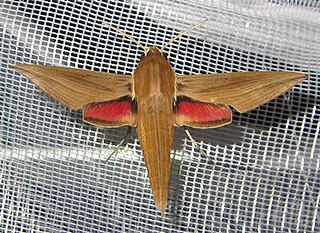
Hippotion eson is a moth of the family Sphingidae. It is very common in most habitats throughout the Ethiopian Region, including Madagascar and the Seychelles. It is a migratory species.

Macroglossum glaucoptera, the dark hummingbird hawkmoth, is a moth of the family Sphingidae. It was described by Arthur Gardiner Butler in 1875. It is known from Sri Lanka, Thailand, southern China, Vietnam, Malaysia (Peninsular), Indonesia and the Philippines (Mindanao). Single specimen recorded from Papua New Guinea.

Macroglossum trochilus, the African hummingbird hawk-moth, is a moth of the family Sphingidae. The species was first described by Jacob Hübner in 1823. It is very common in most habitats throughout southern and eastern Africa and in the Comoro Islands.

Rhadinopasa is a monotypic moth genus in the family Sphingidae erected by Ferdinand Karsch in 1891. Its only species, Rhadinopasa hornimani, was first described by Herbert Druce in 1880. It is known from lowland forest from Gabon, Cameroon and the Central African Republic to the Democratic Republic of the Congo to Uganda and Tanzania.
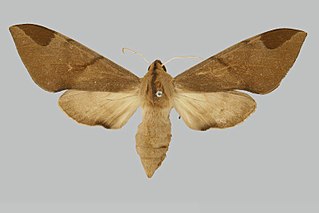
Pseudopolyptychus is a genus of moths in the family Sphingidae, containing one species, Pseudopolyptychus foliaceus, which is known from Guinea, Ivory Coast, Burkina Faso, Togo and from Ghana to Nigeria.

Phylloxiphia metria is a moth of the family Sphingidae. It is known from Brachystegia woodland Mozambique to Zambia and the Democratic Republic of the Congo and north to Malawi and Tanzania.

Odontosida pusillus is a moth of the family Sphingidae first described by Rudolf Felder in 1874. It is known from South Africa.

Antinephele muscosa is a moth of the family Sphingidae. It is found from Ghana to Gabon.
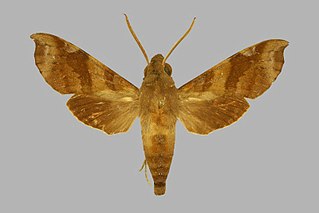
Temnora fumosa is a moth of the family Sphingidae. It is found in most habitats throughout Africa south of the Sahara.
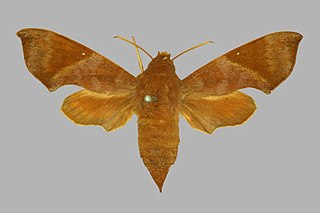
Temnora marginata is a moth of the family Sphingidae first described by Francis Walker in 1856. It is known from savannah and woodland in eastern and southern Africa.

Temnora angulosa is a moth of the family Sphingidae. It is known from Nigeria to Congo.
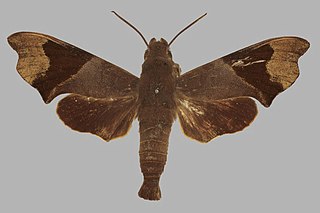
Temnora atrofasciata is a moth of the family Sphingidae. It is known from Forests from western Africa to Congo and Uganda, with an apparently isolated population in the Usambara Mountains.
Temnora griseata is a moth of the family Sphingidae. It is known from forests from Nigeria to southern Congo, southern Tanzania and Malawi.
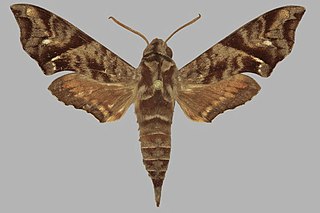
Temnora scitula is a moth of the family Sphingidae. It is known from forests from the Gambia to Congo, Angola and Uganda. There is an isolated population in eastern Tanzania.

Temnora plagiata is a moth of the family Sphingidae. It is found in Africa.
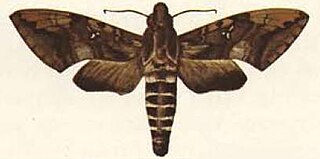
Nephele accentifera, the accented hawk, is a moth of the family Sphingidae. The species was first described by Palisot de Beauvois in 1821. It is common in most habitats throughout the Ethiopian Region, excluding Madagascar and the Cape Peninsula.

Theretra capensis is a moth of the family Sphingidae. It is known from woodland and open habitats from the Cape to Zimbabwe, Zambia, Democratic Republic of the Congo, Malawi, Mozambique and East Africa.

Theretra perkeo is a moth of the family Sphingidae. It is known from the arid areas north of the equatorial forest belt, from Senegal to northern Uganda.
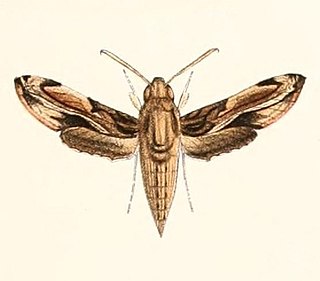
Theretra orpheus is a moth of the family Sphingidae. It is known from most of Africa.

Centroctena rutherfordi is a moth of the family Sphingidaefirst described by Herbert Druce in 1882. It is known from forests from Sierra Leone to Uganda and western Kenya. It is also found in the Usambara Mountains of north-eastern Tanzania.



















